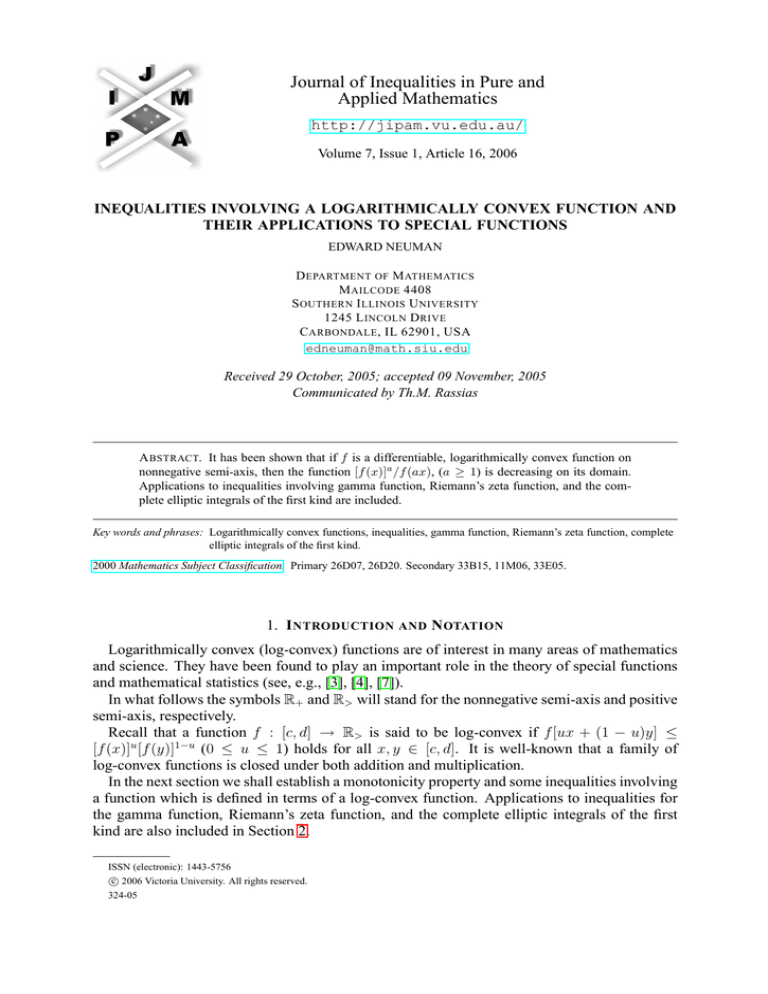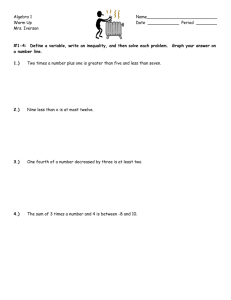
Journal of Inequalities in Pure and
Applied Mathematics
http://jipam.vu.edu.au/
Volume 7, Issue 1, Article 16, 2006
INEQUALITIES INVOLVING A LOGARITHMICALLY CONVEX FUNCTION AND
THEIR APPLICATIONS TO SPECIAL FUNCTIONS
EDWARD NEUMAN
D EPARTMENT OF M ATHEMATICS
M AILCODE 4408
S OUTHERN I LLINOIS U NIVERSITY
1245 L INCOLN D RIVE
C ARBONDALE , IL 62901, USA
edneuman@math.siu.edu
Received 29 October, 2005; accepted 09 November, 2005
Communicated by Th.M. Rassias
A BSTRACT. It has been shown that if f is a differentiable, logarithmically convex function on
nonnegative semi-axis, then the function [f (x)]a /f (ax), (a ≥ 1) is decreasing on its domain.
Applications to inequalities involving gamma function, Riemann’s zeta function, and the complete elliptic integrals of the first kind are included.
Key words and phrases: Logarithmically convex functions, inequalities, gamma function, Riemann’s zeta function, complete
elliptic integrals of the first kind.
2000 Mathematics Subject Classification. Primary 26D07, 26D20. Secondary 33B15, 11M06, 33E05.
1. I NTRODUCTION
AND
N OTATION
Logarithmically convex (log-convex) functions are of interest in many areas of mathematics
and science. They have been found to play an important role in the theory of special functions
and mathematical statistics (see, e.g., [3], [4], [7]).
In what follows the symbols R+ and R> will stand for the nonnegative semi-axis and positive
semi-axis, respectively.
Recall that a function f : [c, d] → R> is said to be log-convex if f [ux + (1 − u)y] ≤
[f (x)]u [f (y)]1−u (0 ≤ u ≤ 1) holds for all x, y ∈ [c, d]. It is well-known that a family of
log-convex functions is closed under both addition and multiplication.
In the next section we shall establish a monotonicity property and some inequalities involving
a function which is defined in terms of a log-convex function. Applications to inequalities for
the gamma function, Riemann’s zeta function, and the complete elliptic integrals of the first
kind are also included in Section 2.
ISSN (electronic): 1443-5756
c 2006 Victoria University. All rights reserved.
324-05
2
E DWARD N EUMAN
2. M AIN R ESULT AND ITS A PPLICATIONS
We are in a position to prove the following.
Theorem 2.1. Let f : R+ → R> be a differentiable, log-convex function and let a ≥ 1. Then
the function
g(x) =
(2.1)
[f (x)]a
f (ax)
decreases on its domain. In particular, if 0 ≤ x ≤ y, then the following inequalities
(2.2)
[f (y)]a
[f (x)]a
≤
≤ [f (0)]a−1
f (ay)
f (ax)
hold true. If 0 < a ≤ 1, then the function g is an increasing function on R+ and the inequalities
(2.2) are reversed.
Proof. We shall prove the theorem when a ≥ 1. Logarithmic convexity of f implies that its
logarithmic derivative α(x) := f 0 (x)/f (x) is an increasing function on R+ i.e., that
(2.3)
α(x) ≤ α(ax).
Logarithmic differentiation of (2.1) gives
0
g 0 (x)
f (x) f 0 (ax)
=a
−
= a α(x) − α(ax) .
g(x)
f (x)
f (ax)
This in conjunction with (2.3) yields g 0 (x) ≤ 0 because g(x) > 0 for all x ∈ R+ . This
proves the monotonicity property of the function g. Inequalities (2.2) now follow because for
0 ≤ x ≤ y, g(y) ≤ g(x) ≤ g(0). The proof is complete.
The remaining part of this section deals with applications of the above result to some special
functions. In what follows we shall always assume that a ≥ 1.
2.1. Inequalities involving the gamma function. Let f (x) = Γ(1 + x) (x ≥ 0). It is well
known that the function f is log-convex
(see, e.g.,
a [3, Theorem 3.5-3]). Making use of Theorem
2.1 we conclude that the function Γ(1 + x)
Γ(1 + ax) decreases for all x ≥ 0 and the
inequalities
a
a
Γ(1 + y)
Γ(1 + x)
(2.4)
≤
≤1
Γ(1 + ay)
Γ(1 + ax)
hold true for 0 ≤ x ≤ y. Inequalities (2.4), when y = 1, have been obtained in [8, (2.3)].
Letting, in (2.4), a = n (n-positive integer) and y = 1 we rediscover inequalities established in
[2].
2.2. Inequalities for the Riemann zeta function. A beautiful formula which connects Euler’s
gamma function and Riemann’s zeta function
Z ı x
t
(2.5)
Γ(1 + x)ζ(1 + x) =
dt (x > 0)
t
0 e −1
is well known (see, e.g., [1, 23.2.7]). Applying Theorem B.6 in [3, pp. 296–297]) to the integral
in (2.5) we conclude that the function f (x) := Γ(1 + x)ζ(1 + x) is log-convex for all x ∈ R> .
Making use of the first inequality in (2.2) we arrive at
a
a
Γ(1 + y)ζ(1 + y)
Γ(1 + x)ζ(1 + x)
(2.6)
≤
Γ(1 + ay)ζ(1 + ay)
Γ(1 + ax)ζ(1 + ax)
J. Inequal. Pure and Appl. Math., 7(1) Art. 16, 2006
http://jipam.vu.edu.au/
I NEQUALITIES I NVOLVING A L OGARITHMICALLY C ONVEX F UNCTION
3
(0 < x ≤ y). Application of the second inequality in (2.4) to the right side of (2.6) gives,
a
a
Γ(1 + y)ζ(1 + y)
ζ(1 + x)
(2.7)
≤
.
Γ(1 + ay)ζ(1 + ay)
ζ(1 + ax)
Substituting y = 1 into (2.7) and taking into account that Γ(2) = 1 and ζ(2) = π 2 /6 we obtain
a
2 a
ζ(1 + x) ζ(1 + a)
π
1
≤
6
Γ(1 + a)
ζ(1 + ax)
(0 < x ≤ 1).
Another inequality
a
2 a
1/2+ax
ζ(1
+
x)
ζ(1 + a)
π
(1
+
ax)
(2.8)
≤
ea(1−x)
1/2+a
6
(1 + a)
ζ(1 + ax)
(0 < x ≤ 1), with equality if x = 1, also follows from (2.6). We let y = 1 to obtain
a
2 a
ζ(1 + x) ζ(1 + a)
π
Γ(1 + ax)
a ≤
(2.9)
.
6
ζ(1 + ax)
Γ(1 + a) Γ(1 + x)
Taking into account that 1 ≤ 1/Γ(1 + x) for 0 ≤ x ≤ 1 and applying an inequality of J.D.
Kečkić and P.M. Vasić [5]
uu−1/2
Γ(u)
ev−u v−1/2 ≤
v
Γ(v)
(1 ≤ u ≤ v) to Γ(1 + ax)/Γ(1 + a) we conclude that the left-hand side of the inequality (2.9)
is bounded from below by the first member of (2.8).
2.3. Applications to elliptic integrals. The complete elliptic integral of the first kind RK (x, y)
(x, y ∈ R> ) is defined by
Z
2 π/2
(2.10)
RK (x, y) =
(x sin2 θ + y cos2 θ)−1/2 dθ
π 0
(see [3, Ch. 9]). It follows from Proposition 2.1 in [6] that RK (x, y) is log-convex in each of its
variables. For z > 0 let f (x) = RK (x, z). Using the first inequality in (2.2) we have
a
RK (y, z)
RK (ay, z)
(2.11)
≤
RK (x, z)
RK (ax, z)
(0 < x ≤ y).
The complete elliptic integral of the first kind in Legendre form, denoted by K(k), is defined
by
Z π/2
K(k) =
(1 − k 2 sin2 θ)−1/2 dθ.
0
π
R (k 02 , 1), where
2 K
02
02
k 02 = 1−k 2 . Assume that 0 < l ≤ k
Making use of (2.10) we have K(k) =
and let l02 = 1 − l2 . Letting, in (2.11), x = k , y = l , z = 1 we obtain
a
K(l)
K(m)
≤
,
K(k)
K(r)
where m2 = 1 − al02 and r2 = 1 − ak 02 .
J. Inequal. Pure and Appl. Math., 7(1) Art. 16, 2006
http://jipam.vu.edu.au/
4
E DWARD N EUMAN
R EFERENCES
[1] M. ABRAMOWITZ AND I.A. STEGUN (Eds.), Handbook of Mathematical Functions with Formulas, Graphs and Mathematical Tables, Dover Publications, Inc., New York, 1965.
[2] C. ALISINA AND M.S. TOMÁS, A geometrical proof of a new inequality for the gamma function, J. Ineq. Pure Appl. Math., 6(2) (2005), Art. 48. [ONLINE: http://jipam.vu.edu.au/
article.php?sid=517]
[3] B.C. CARLSON, Special Functions of Applied Mathematics, Academic Press, New York, 1977.
[4] H. KAZI AND E. NEUMAN, Bounds for elliptic integrals, in preparation.
[5] J.D. KEČKIĆ AND P.M. VASIĆ, Some inequalities for the gamma function, Publ. Inst. Math.
Beograd (New Series), 11 (1971), 107–114.
[6] E. NEUMAN AND J. SÁNDOR, On the Schwab-Borchardt mean II, Math. Pannonica, 17(1) (2006),
to appear.
[7] J.E. PEČARIĆ, F. PROSCHAN AND Y.L. TONG, Convex Functions, Partial Orderings and Statistical Applications, Academic Press, Boston, 1992.
[8] J. SÁNDOR, A note on certain inequalities for the gamma function, J. Ineq. Pure Appl. Math., 6(3)
(2005), Art. 61. [ONLINE: http://jipam.vu.edu.au/article.php?sid=534]
J. Inequal. Pure and Appl. Math., 7(1) Art. 16, 2006
http://jipam.vu.edu.au/






